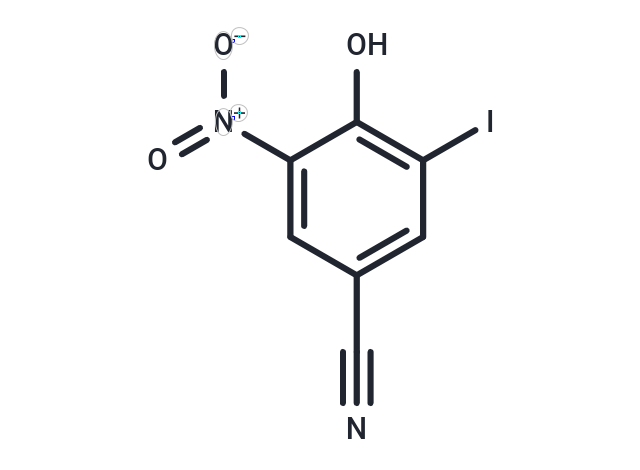Shopping Cart
Remove All Your shopping cart is currently empty
Your shopping cart is currently empty
Nitroxynil (4-Hydroxy-3-iodo-5-nitrobenzonitrile) is an anthelmintic compound that effectively targets parasites in both adult and immature stages. It is extensively employed in investigations pertaining to Fasciola hepatica infection.

| Pack Size | Price | USA Warehouse | Global Warehouse | Quantity |
|---|---|---|---|---|
| 1 g | $29 | - | In Stock | |
| 1 mL x 10 mM (in DMSO) | $29 | - | In Stock |
| Description | Nitroxynil (4-Hydroxy-3-iodo-5-nitrobenzonitrile) is an anthelmintic compound that effectively targets parasites in both adult and immature stages. It is extensively employed in investigations pertaining to Fasciola hepatica infection. |
| Synonyms | Trodax, Dovenix, 4-Hydroxy-3-iodo-5-nitrobenzonitrile |
| Molecular Weight | 290.01 |
| Formula | C7H3IN2O3 |
| Cas No. | 1689-89-0 |
| Smiles | OC1=C(I)C=C(C=C1[N+]([O-])=O)C#N |
| Storage | Powder: -20°C for 3 years | In solvent: -80°C for 1 year | Shipping with blue ice/Shipping at ambient temperature. | |||||||||||||||||||||||||||||||||||
| Solubility Information | DMSO: 50 mg/mL (172.41 mM), Sonication is recommended. | |||||||||||||||||||||||||||||||||||
| In Vivo Formulation | 10% DMSO+40% PEG300+5% Tween 80+45% Saline: 2 mg/mL (6.9 mM), Sonication is recommended. Please add the solvents sequentially, clarifying the solution as much as possible before adding the next one. Dissolve by heating and/or sonication if necessary. Working solution is recommended to be prepared and used immediately. The formulation provided above is for reference purposes only. In vivo formulations may vary and should be modified based on specific experimental conditions. | |||||||||||||||||||||||||||||||||||
Solution Preparation Table | ||||||||||||||||||||||||||||||||||||
DMSO
| ||||||||||||||||||||||||||||||||||||
| Size | Quantity | Unit Price | Amount | Operation |
|---|

Copyright © 2015-2026 TargetMol Chemicals Inc. All Rights Reserved.